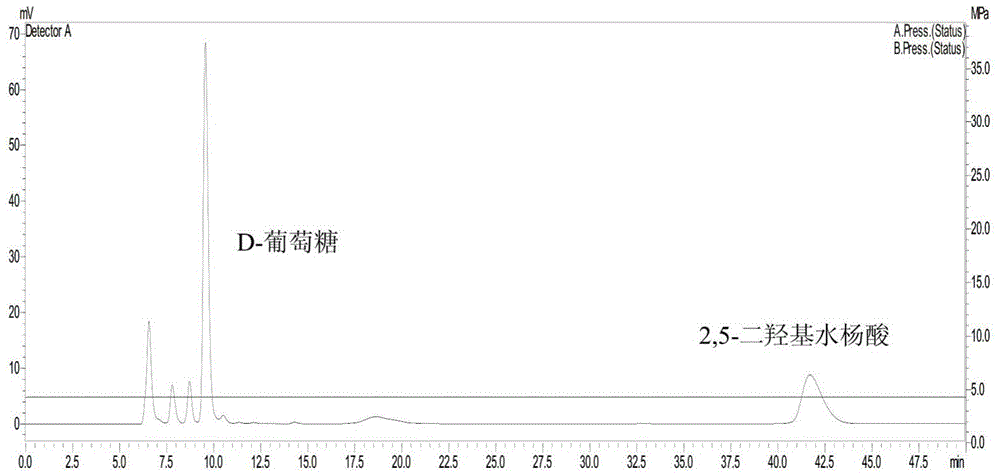Composition for disaggregating lignocelluloses and method for disaggregating lignocelluloses by virtue of composition
A technology of lignocellulose and depolymerization, applied in the fields of biochemical equipment and methods, enzymes, oxidoreductases, etc., can solve the problems of little guiding significance, unclear mechanism of action, and less obvious synergy.
- Summary
- Abstract
- Description
- Claims
- Application Information
AI Technical Summary
Problems solved by technology
Method used
Image
Examples
Embodiment 1
[0037] Isolate and purify the dehydrogenase in the composition of the present invention from the extracellular enzyme liquid of Penicillium juniper:
[0038] Penicillium piceum (Penicillium piceum) H16, preservation number: CGMCC No. 8339, preservation unit China General Microbiological Culture Collection Center (china general microbiological culture collection center).
[0039] For Penicillium juniper, the most suitable medium conditions are as follows: 3.3% microcrystallinecellulose, 1.7% corncobsteepliquor, 0.5% (NH4) 2 SO 4 , 0.6% KH 2 PO 4 , 0.1% MgSO 4 , 0.25% CaCO 3 , and 0.2% Tween-80. The glass container used for fermentation generally chooses a 300mL Erlenmeyer flask, cultivates 50mL of the culture solution, and shakes it horizontally at 180rpm in a 28-degree incubator for 5 days.
[0040] The instrument used for dehydrogenase separation and purification is AKTApurifier (GE, Sweden). Using acetic acid-sodium acetate solution with a pH value of 4.8-5.0 and a sub...
Embodiment 2
[0043] Enzyme activity assay of dehydrogenase:
[0044] Application of the conventional methods in the art cellulase and hemicellulase national standard assay method composition-dehydrogenase to carboxymethylcellulose (CMC-Na), salicin (Salicin), PNPC, microcrystalline cellulose ( Avicel), xylan (Xylan), PNPG, and cellobiose were tested for enzyme activity, and the test results are shown in Table 1 below: the composition was found to have no glycoside hydrolase activity.
[0045] Table 1. Preliminary analysis of enzymatic properties of dehydrogenases
[0046]
Embodiment 3
[0048] Research on the mechanism of action of the dehydrogenase of the present invention
[0049] When dehydrogenase was added to the crude enzyme solutions of Trichoderma reesei and Penicillium juniperus at a protein concentration of 40 μg / mL, the hydrolysis efficiencies of the crude enzyme solutions of Trichoderma reesei and Penicillium juniperi increased by 27% and 35%, respectively. %. This is the first time that a dehydrogenase has been found in a cellulase system. The dehydrogenase itself has no enzymatic activity, and there is a strong synergistic effect with the cellulase, so the dehydrogenase belongs to the cellulase synergistic composition, such as figure 2 shown.
[0050] The dehydrogenase protein did not detect hydrolase activity, but when it treated four kinds of lignocellulosic materials with different components, when the hydrolyzate was analyzed by HPLC-42A, it was found that there was a small amount of D-glucose and D-glucose in the hydrolyzate - Sorbitol, ...
PUM
 Login to View More
Login to View More Abstract
Description
Claims
Application Information
 Login to View More
Login to View More - R&D
- Intellectual Property
- Life Sciences
- Materials
- Tech Scout
- Unparalleled Data Quality
- Higher Quality Content
- 60% Fewer Hallucinations
Browse by: Latest US Patents, China's latest patents, Technical Efficacy Thesaurus, Application Domain, Technology Topic, Popular Technical Reports.
© 2025 PatSnap. All rights reserved.Legal|Privacy policy|Modern Slavery Act Transparency Statement|Sitemap|About US| Contact US: help@patsnap.com



